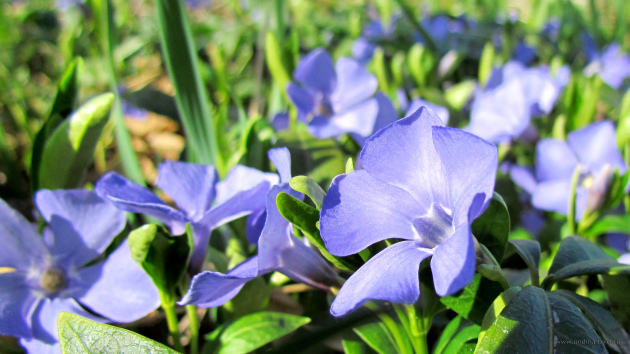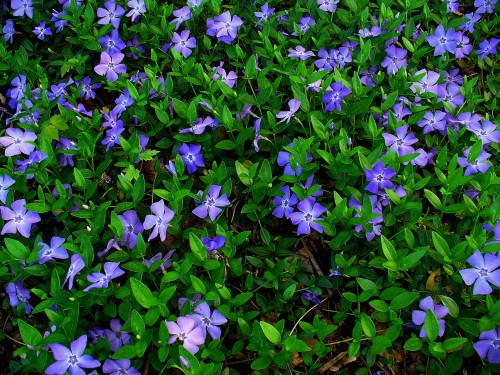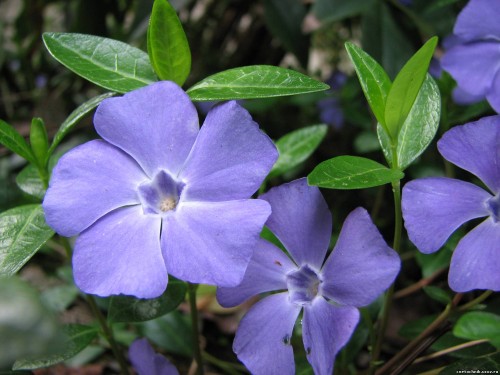Barwin is an amazing plant that can be found in forests, gardens, parks and many other places. Many people who are engaged in the cultivation of Barwinka note that this plant culture is distinguished by incredible vitality and resistance to various harsh conditions. Therefore, even in the most unsuitable places, cherished flowers with purple color can be found. In addition, many of course, many know that these worst Barwinka can hold out for a long time in a vase while there is at least a few drops of water.
Also, Barwinka quickly keeps the roots, actively develops and demonstrates a colossal growth, whatever around the condition.
Many European peoples consider Barwin to be a magical, or even a plant associated with the devil himself. This is due, first of all, with an incredible vitality of the plant. Some people believed that Barwinka prevents lightning strikes, so the flowers planted the entire territory around the house.
Despite all these fictions associated with Barquincom, the plant really has many positive properties that need to clearly mention.
In this article, we will look at the main parts related to the landing and leaving for Barquincom. We will also analyze many other aspects of plant culture, among which pests, Barvinka's diseases, as well as the conditions in which the semi-staple feels comfortable.
Features of Barwinka
As we said, hundreds of years ago, people attributed to Barvinka amazing properties, and sometimes it was even about magical phenomena. Surely it is due to the fact that Barwin really has some positive properties. The plant is actively used in folk medicine, in particular, Barwin demonstrates efficiency in diarrhea, dental pain, bleeding. Moreover, the plant contains substances (antitumor alkaloids), which are used in creating vital drugs.
To date, the prevalence has acquired 6 types of Barwinka, which grow at different ends of the world. In particular, we are talking about Africa, Europe, Mediterranean and Asia.
By itself, the semi-staple is a culture that has single flowers, located in the sinuses of the leaves. So, the whin is a long cylindrical tube.
To date, this plant can be found on various garden and summer cottages. Barwinka's unique flowers create a cozy atmosphere, especially if a lot of half-workers are planted. In some situations, the plant practically fits perfectly into the existing conditions. Barwinka is well combined with many plants that can be on a specific site, but even single flowers look attractive.
Types of Barwinka
Small Barquinet
This plant is distinguished by frost resistance, as well as low-demanding environmental conditions. With a high probability, this kind of Barwinka will delight active growth even if the care is not performed at all. Most often, small Barwin is found in Europe. The plant has long shoots, as well as long leathery leaves, distinguished by a dark green tint. Surprisingly, these leaves do not even die out for the winter, which makes Barwin in a truly resistant to the external conditions of the plant.
The bloom of small Barwinka occurs around May and until mid-June. Flowers here are single, however large, their diameter is up to 5 cm. If you produce high-quality care, then you can not exclude re-blossom at the very end of summer. The good news is that the solid cover of this type of Barwinka is almost always different, since the old leaves of the semi-staple die too slowly.
It is also interesting that not so long ago, Barwinka forms were derived, which are distinguished by pink, whitish, as well as reddish leaves. Accordingly, this is the very aspect associated with the decorative component of the site using a semi-station.
Small Barwin is called one of the most stable plants due to the fact that it easily tolerates pulling, the field of which continues to actively grow, no matter how it happens.
Grassy Barquinet
Often this species is found in the territories of the Caucasus, Carpathians and the Crimea. The plant is distinguished by long shoots (meter or more), which are merged with small leaves, rigid with a dark green color. Ultimately, the cover is obtained as thick as in the case of a small balquin. Blue Barwinka flowers are distinguished by flowering at the beginning of summer and for 25 days. For maximum growth of Barwinka, the illuminated, but dry places in which the plant feels in complete comfort. At the same time, it is necessary to pay attention to the fact that herbaceous Barwinka poorly tolerates increased humidity.
Picky Barquinet
This type of Barwinka is often found in the Forests of the Caucasus, close to the water bodies. This plant is characterized by active growth, even if the surrounding conditions differ in some kind of severeness. The bloom of the semi-staple occurs in the end of spring and early summer. Single flowers have a diameter of up to 3.5 cm. The plant looks surprising, especially if there is a massive green carpet. Late autumn leaves fall away. In winter, the young shoots of the published Barwinka need to be protected from external conditions, since, for example, severe frosts, it can be too negatively affected by the state of the plant.
Big Barwin
This species grows in a variety of regions of the world, starting with North Africa, and finishing Asia. This semi-station is characterized by the fact that it rises above the ground by about 30 cm in height. Barwinka has large leaves, bluish flowers with a diameter of up to 4 cm. It is also interesting that the plant is extremely rapidly growing and covers the carpet from the leaves huge areas. Sorts are available for gardeners with yellow and white leaves. In the winter period, Barvinok is advisable to cover the cauldron.
Place for landing
As you know, for many plants, the landing place has a tremendous value. Moreover, in certain situations, the activity of the growth of culture depends on this, and sometimes it is just an opportunity to develop.
To begin with, I would like to say that Barwinka is the very plating that feels in comfort practically in any conditions. This suggests that it can be planted on the plain, and on the slope, in a sunny place, or by the fact where only the shadow is often. Despite this, there are important conditions that significantly affect vegetation.
- Increased humidity. In such conditions, Barwin feels bad enough. However, it is not necessary to think that with this situation, the plant simply stops growing. It will develop far away as much as I would like. Just on the plot there are places where the humidity is slightly higher than on the rest of the territory. Despite all this, a certain watering of the Barwinka is still done.
- Continuous solar radiation. But these conditions, oddly enough, like Barvinka. The semi-staple is actively developing, and also pleases the high rigidity of the leaves and the saturated color of flowers.
As for the illumination of the site, then often Barwinka requires an average level of light, which is sufficient for the optimal development of culture.
If we talk about the choice of the soil for landing Barwinka, it is often recommended to pay attention to the fertile soil, which is distinguished by a small loyalty. Thus, the semi-staple will differ high growth activity. Despite this, often Barwin feels and in any other conditions. Often, it is possible to find this plant in a wide variety of localities, and often it demonstrates phenomenal growth even on sufficiently severe conditions in terms of conditions. Despite this, it is impossible to exclude that if the landing is produced in not the most suitable conditions, the plant will develop extremely badly. Subject to the above recommendations, the likelihood of obtaining a decent plant increases significantly.
Landing Barwinka
Despite the fact that Barwinka can please actively grow in almost any conditions, landing and care for this semi-staple - sometimes a difficult task. However, if you do everything logical, then no problems will arise.
Often the landing occurs at the very end of summer, or at the beginning of the spring season. Specialists believe that to obtain a truly chic externally, it is necessary to carry out similar events in early September.
Accordingly, it all occurs on the basis of pure soil, the planting scheme is used 30x30 cm. In the event that the landing was carried out in the spring period, then the first autumn cold of the Barvinka will be a full-fledged plant.
Spring and autumn fit can be made by dividing the bush, as well as cuttings. It is also worth paying attention to the fact that at the cool period it is necessary to cover the plant with a layer of leaves. Moreover, it is necessary to do for all types of Barwinka, even for those that differ in frost resistance.
Barvinkcom care
Many produce landing of Barwinka on their plot for the reason that this plant is not picky for cultivation. Despite this, if not to carry out enough care, it is possible to obtain a far from the most attractive semi-staple. This is due to the fact that the conditions for Barwinka can be the most diverse, so it makes sense to remember this in advance and have already pre-made some conclusions.
Thus, Barwin reacts positively to various feeding. However, it is important to remember that they all should be made in a timely manner and to the place. For Barwinka, mineral and organic fertilizers are often used. Experts recommend to make a choice in favor of compost and humus.
As for the watering of Barwinka, the situation here is quite interesting. Practice shows that Barwinka is characterized by low-demanding moisture. Despite this, if the summer is arid, then a small watering will definitely not be superfluous. Small rains that often pass in the summer, often enough for Barwin to actively develop and pleased with its appearance of the hosts. Sometimes in the summer period on the flowers and leaves of Barwinka, you can find dust that should be flucked off with a small pressure of water. In addition, a small moisturizing of dry soil will also not hurt.
Often, a lot of weeds can be found around Barwinka, which, fortunately, do not create any special problems for the semi-staple. It should be borne in mind that a small sweeping of unnecessary plants is still required. This is necessary at least for Barwin to be pleased with his beauty. Surprisingly, in some cases, even weeds are well combined with our plant, so it is necessary to analyze the situation in advance before doing something.
It should also be borne in mind that in order to increase the possibility of Barwinka's bunning, the caption is necessary for young and old shoots. Experts note that it is an extremely important aspect that needs to be taken into account all owners.
We have already talked about the winter period, which will have to have every placed Barvinka. Practice shows that winter tolerate all Barwinka, even if you do not hold any special events. But at the same time you need to remember that with this situation there is a high probability of losing young shoots. Moreover, such situations arise even if it comes to the frost-resistant species of Barwinka. It is logical that it is best to cover the Barwin on the winter period, and this will definitely retain a semi-staple safe and preservation.
Using Barwinka
It should be borne in mind that many people grow Barwin for the reason that this semi-staple has a lot of positive properties, about the parts of which we have already spoken earlier in this material.
Despite this, it is necessary to understand that Barwin is a good remedy for drugs. It should be said that, as a full-fledged drug, the Barwin cannot be used, however, for prevention and with sufficiently simple diseases, this is a good tool. Accordingly, at the end of the summer season, the billet is made, which is further used for certain purposes.
Often, Barwinka is quite effective in disorders, diarrhea, intestinal diseases. Moreover, the plant often helps to fight migraine.
At the same time, Barwinka flowers are a good ornamental agent that is used to decorate houses and many other spaces. Room Barwin is a fairly popular plant, with which it is quite possible to embellish the room.
Diseases and pests of Barwinka
The very strong side of Barwinka is the fact that this plant is practically not affected by pests. Therefore, even in wildlife conditions, the semi-staple demonstrates an otnaya growth.
However, experts note that in rare cases, Barwin suffers from the influence of the so-called shields. These are insects that gradually eat the leaves of the plant. Especially bad if the situation associated with the effect of insect data, too launched.
Fortunately, on sale you can find the appropriate means that can be used to spray a semi-staple. Several approaches will allow to get rid of pests that cause a serious damage to the plant. If the shields are located on Barquinka for too long ago, then it is impossible to exclude the deplorable state of the semi-staple. This, of course, is extremely rare if there is at least a minimal care for Barquincom.
If Barwinka is planted on a plot that is not attended so often, it is quite possible to detect unpleasant surprises associated with the state of the plant. However, this also applies to many other cultures, first of all, those that can significantly suffer from various pests and diseases. Therefore, it is always worth analyzing the situation so that then suddenly do not encounter large problems. Regular care eliminates almost all problems available on the site.



















 Start a discussion ...
Start a discussion ...